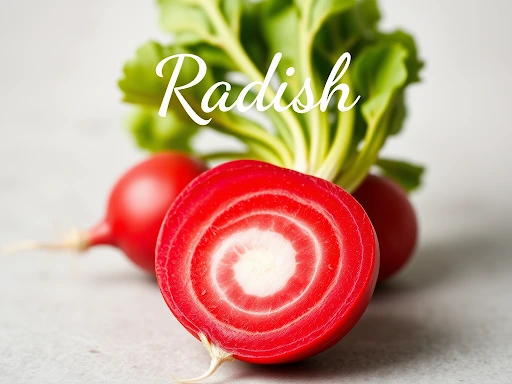The Cultivation, Varieties, Nutrition, and Cultural Importance of the Raddish
The Radish is one of the most unappreciated vegetables, however, its broad culinary history, health benefits and features make it a well rounded vegetable. They offer stunning flavor and unique texture when enjoyed raw in salads, cooked in stews or fermented in kimchis. They are also a rich source of vitamins as well as offering some medicinal benefits. This article discusses the nutritional profile of radish, its varieties, methods of cultivation, how it is used domestially and abroad, and its value in different cultures.
1. The Nutritional Benefits of Radish
Benefits of Radishes as a Healthy Vegetable
Radishes (Raphanus sativus) are members of the family Brassicaceae like cabbage, broccoli and mustard greens. The family of root vegetables are caracterized by different shapes, colors and flavors, offering a refreshing crunch and a peppery flavor. In addition to being flavorful, they can also be a wonderful source of low calorie food alongside being high in fiber and other nutrients.
Nutritional content in Radishes
Though radishes appear to be diminutive in size, they serve as high nutritional value vegetables. Some prominent nutrients constituent in raddishes include:
Vitamin C – Which serves to strengthen immunity as well as facilitates healthy skin
Potassium – Which Helps in the control of blood pressure, regulates muscle activity, improves recovery post exercise
Folate – Aids in cell division and helps in DNA construction and destruction.
Fiber – Helpful in the process of digestion and relieves constipation.
Antioxidants – Minimizes Chronic inflammation and oxidative stress which leads to cell destruction.
How Radish Enhances Digestion and Immunity
Raddishes have self digestive enzymes along with fibers that aid in digestion. Their high water content also helps in constipation prevention and fiber aids in fostering healthy gut. The presence of Antimicrobial compounds aids in infection treatment and ultimately helps in boosting immunity.
How Radish May Help With Weight Loss
If looking to range within healthy body weight, raddishes will be a great part of their diet. They are:
Low in calories (approximately 16 calories per 100g),
Hydrating, helping with metabolism and detoxification,
High in fiber which helps keep one fuller for longer.
Best Ways to Include Raddish in a Balanced Diet
Slice raddish and add it to salads for extra crunch.
Add raddishes into soup and stew for a peppery flavor.
Raddish serves as a great pickled vegetable side dish as it is tangy and probiotic-rich.
Blend raddish into smoothie or juice for detox benefits.
Roasting raddish brings out sweetness it has and makes them taste better.
2. Different Varieties of Radish and Their Uses
Overview of Common Radish Types
Watermelon radish, French breakfast raddish, and black raddish are some of the most recognizable ones, most raddish types bear different colors, shape and taste.
Red Raddish – round, small in size with slightly spicy flavor.
White Raddish (Daikon) – long, mild in flavor, highly used in Asian meals.
Black Radish – pungent and a bit peppery, often used for medicine.
Watermelon Radish – mild flavored, with pink center and green outer part.
French Breakfast Radish – has a bit firm and adds mild flavor to dishes.
Daikon radishes can be eaten raw or cooked as they have a mild flavor.
Black radishes have a pungent taste that is best suited for soups or medicine.
Watermelon radishes are slightly sweet and improve the aesthetic of food.
Best Culinary Uses for Each Variety
Red, watermelon, and French breakfast radishes: Raw salads
Daikon and red raddishes: Pickling
Cooking Daikon and black raddishes:
Watermelon radish for vibrant plating: Garnish
Seasonal Availability of Radish Types
Redishes, including French, are best harvested in spring and fall. Certain ones, such as daikon, prefer to be harvested during the winter months as they grow in colder climates.
Choosing the Right Radish for Your Dish
Daikon and French breakfast radish are your go to choice for mildly flavored dishes.
Black and red radishes are ideal for highly spiced dishes.
Use watermelon radish for appealing salads.
- Growing Radish at Home: A Beginner’s Guide
Choosing the Right Soil and Climate for Radish
Guidelines for Planting and Garden Layout
Plant seeds into the ground as they do not move well
In order to enable proper growth, space seeds between 1-2 inches.
To avoid overcrowding, thin seedlings after they sprout.
Adequate Water, Light, and Temperature for Growing Radishes
While sunlight encourages firm, flavorful roots to develop, radishes require constant moisture but should not be over watered.
Radish Plants’ Most Significant Pests and Diseases
Aphids and flea beetles – Use neem oil or companion planting for control.
Root rot – Avoid overwatering and ensure good drainage.
Powdery mildew – Provide adequate air circulation and avoid overhead watering.
How To Harvest and Store Radishes
Harvest red radishes in 3-4 weeks and daikon in 60+ days.
Store radishes in the fridge wrapped in a damp paper towel for best results.
- Radish Cuisine Around The World
Radish in Asia
Korean kimchi (fermented spicy radish).
Pickled daikon and miso soup in Japan.
Stir fried radish cakes from China.
European Consumption of Radish
Buttered radish with salt in France.
Radish salad and sandwiches in Germany.
Pickled radish chutney in Britain.
Latin American and Radish
Radishes in taco and salsa from Mexico.
Curtido frequently served as a side dish in El Salvador.
How Radish Is Used in Indian Cuisine
Mooli paratha (flatbread stuffed with grated radish).
Radish curry and sambar (lentil soup with radish).
Culinary Uses of Radish around the globe
Raw radish served with butter and salt in France.
Radish topped street tacos in Mexico.
Fermented radish side dishes in Korea.
5. The Cultural Heritage of Radish
Where Radish Began and How It Was Bred For Domestication
It’s thought that the more than four thousand year old domesticated radish originated from Egypt and China.
The History of Radish Consumption in Ancient Cultures
The Egyptians used to eat radishes along with garlic and onions.
Japanese athletes believed radish helped them get more stamina.
In China, radishes were prescribed to patients who had digestion problems.
Therapeutic Use of Radish in Ancient Medicine
For detoxifying the liver, black radish was used.
To treat respiratory illnesses, daikon radish was used.
For digestive issues, patients were prescribed radish juice.
Celebration and Festivals with Cultural Importance of Radish
Mexico celebrates the Night of the Radishes, a festive event where people carve radishes.
In Chinese and Korean cultures, the Lunar New Year is celebrated as the radish is considered a symbol of good fortune.
Radish’s Popularity in Modern Day
Radishes have now gained a lot of popularity in both healthy diets and farm-to-table restaurants as a nutritious and multifaceted vegetable.
Summary
Not only do radishes serve as a crunchy garnish, but they also have deep cultural roots. Additionally, they are easy to cultivate, which makes them ideal to include in any diet. Whether in salads, soups, or pickles, radishes add flavor and history to every meal. Try incorporating more radishes into your meals and uncover their culinary potential! 🚀
Read also: Raddishes and Their Plentiful Benefits: From Medicines To Sustainability


Leave a Reply